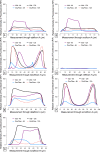Differential Deposition of Fluorescently Tagged Cholesterol on Commercial Contact Lenses Using a Novel In Vitro Eye Model
- PMID: 29644148
- PMCID: PMC5892225
- DOI: 10.1167/tvst.7.2.18
Differential Deposition of Fluorescently Tagged Cholesterol on Commercial Contact Lenses Using a Novel In Vitro Eye Model
Abstract
Purpose: We evaluate the differences in lipid uptake and penetration in daily disposable (DD) contact lenses (CL) using a conventional "in-vial" method compared to a novel in vitro eye model.
Methods: The penetration of fluorescently labelled 22-(N-(7-Nitrobenz-2-Oxa-1,3-Diazol-4-yl)Amino)-23,24-Bisnor-5-Cholen-3beta-Ol (NBD)-cholesterol on three silicone hydrogel (SH) and four conventional hydrogel (CH) DD CLs were investigated. CLs were incubated for 4 and 12 hours in a vial, containing 3.5 mL artificial tear solution (ATS), or were mounted on an in vitro eye-blink platform designed to simulate physiologic tear flow (2 mL/24 hours), tear volume and "simulated" blinking. Subsequently, CLs were analyzed using laser scanning confocal microscopy and ImageJ.
Results: Penetration depth and fluorescence intensities of NBD-cholesterol varied between the incubation methods as well as lens materials. Using the traditional vial incubation method, NBD-cholesterol uptake occurred equally on both sides of all lens materials. However, using our eye-blink model, cholesterol penetration was observed primarily on the anterior surface of the CLs. In general, SH lenses showed higher intensities of NBD-cholesterol than CH materials.
Conclusions: The traditional "in-vial" incubation method exposes the CLs to an excessively high amount of ATS, which results in an overestimation for cholesterol deposition. Our model, which incorporates important ocular factors, such as intermittent air exposure, small tear volume, and physiological tear flow between blinks, provides a more natural environment for in vitro lens incubation.
Translational relevance: In vitro measurements of CLs are a common approach to predict their interactions and performance on the eye. Traditional methods, however, are rudimentary. Therefore, this study presents a novel in vitro model to evaluate CLs, which consequently will enhance elucidations of the interactions between CLs and the eye.
Keywords: cholesterol; contact lens; conventional hydrogel; daily disposable; deposition; eye model; laser scanning confocal microscopy; lipid; silicone hydrogel.
Figures





Similar articles
-
Effects of Temperature and Blinking on Contact Lens Dehydration of Contemporary Soft Lens Materials Using an In Vitro Blink Model.Transl Vis Sci Technol. 2021 Jul 1;10(8):11. doi: 10.1167/tvst.10.8.11. Transl Vis Sci Technol. 2021. PMID: 34251425 Free PMC article.
-
Deposition of Fluorescently Tagged Lysozyme on Contact Lenses in a Physiological Blink Model.Eye Contact Lens. 2021 Feb 1;47(2):127-133. doi: 10.1097/ICL.0000000000000683. Eye Contact Lens. 2021. PMID: 31789754
-
Novel in vitro method to determine pre-lens tear break-up time of hydrogel and silicone hydrogel contact lenses.Cont Lens Anterior Eye. 2019 Apr;42(2):178-184. doi: 10.1016/j.clae.2018.11.002. Epub 2018 Nov 12. Cont Lens Anterior Eye. 2019. PMID: 30442514
-
Bioinspired hydrogels for drug-eluting contact lenses.Acta Biomater. 2019 Jan 15;84:49-62. doi: 10.1016/j.actbio.2018.11.020. Epub 2018 Nov 16. Acta Biomater. 2019. PMID: 30448434 Review.
-
Impact of the physical properties of contact lens materials on the discomfort: role of the coefficient of friction.Colloids Surf B Biointerfaces. 2024 Jan;233:113630. doi: 10.1016/j.colsurfb.2023.113630. Epub 2023 Nov 4. Colloids Surf B Biointerfaces. 2024. PMID: 37956592 Review.
Cited by
-
In vitro Evaluation of the Location of Cholesteryl Ester Deposits on Monthly Replacement Silicone Hydrogel Contact Lens Materials.Clin Ophthalmol. 2020 Sep 24;14:2821-2828. doi: 10.2147/OPTH.S270575. eCollection 2020. Clin Ophthalmol. 2020. PMID: 33061266 Free PMC article.
-
Analysis of Deposition and Diffusion of Cholesterol in Silicone Hydrogel Contact Lenses Using Confocal Microscopy.Vision (Basel). 2024 Sep 20;8(3):55. doi: 10.3390/vision8030055. Vision (Basel). 2024. PMID: 39311323 Free PMC article.
-
Effects of Temperature and Blinking on Contact Lens Dehydration of Contemporary Soft Lens Materials Using an In Vitro Blink Model.Transl Vis Sci Technol. 2021 Jul 1;10(8):11. doi: 10.1167/tvst.10.8.11. Transl Vis Sci Technol. 2021. PMID: 34251425 Free PMC article.
-
Analysis of polyvinyl alcohol release from commercially available daily disposable contact lenses using an in vitro eye model.J Biomed Mater Res B Appl Biomater. 2019 Jul;107(5):1662-1668. doi: 10.1002/jbm.b.34259. Epub 2018 Oct 16. J Biomed Mater Res B Appl Biomater. 2019. PMID: 30325095 Free PMC article.
-
Development of an Eye Model With a Physiological Blink Mechanism.Transl Vis Sci Technol. 2019 Sep 3;8(5):1. doi: 10.1167/tvst.8.5.1. eCollection 2019 Sep. Transl Vis Sci Technol. 2019. PMID: 31534830 Free PMC article.
References
-
- Young G, Veys J, Pritchard N, Coleman S. . A multi-centre study of lapsed contact lens wearers. Ophthalmic Physiol Opt. 2002; 22: 516– 527. - PubMed
-
- Dumbleton K, Woods CA, Jones LW, Fonn D. . The impact of contemporary contact lenses on contact lens discontinuation. Eye Contact Lens. 2013; 39: 93– 99. - PubMed
-
- Pritchard N, Fonn D, Brazeau D. . Discontinuation of contact lens wear: a survey. Int Contact Lens Clin. 1999; 26: 157– 162. - PubMed
-
- Nicolson PC, Vogt J. . Soft contact lens polymers: an evolution. Biomaterials. 2001; 22: 3273– 3283. - PubMed
-
- Tighe B. . Silicone hydrogels: structure, properties and behaviour. : Sweeney D, . Silicone Hydrogels: Continuous Wear Contact Lens. 2. Oxford: Butterworth-Heinemann; 2004: 1– 27.
LinkOut - more resources
Full Text Sources
Other Literature Sources

